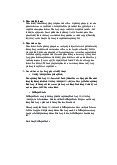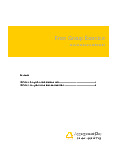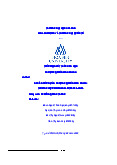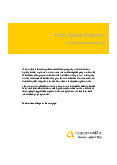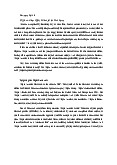



















Preview text:
BRITAX STATE OF SAFETY REPORT A Pan-European Study into Parental Attitudes to Childhood Mobility Safety Contents | Foreword very year thousands of
for the new arrival, right through
At Britax, we are dedicated to young babies and children to when they’re growing up, helping make some of those
are kil ed or injured whilst in
there is considerable confusion a vehicle or on the move, the and safety can sometimes be
decisions a little easier because
majority in car crashes1. Some
overlooked in favour of conveni-
we believe family freedom starts are unavoidable. ence or cost. with being safe. However, many could be
As a parent myself, I understand From car seat instal ation prevented if more people were
both the thril s and challenges of systems and impact protection equipped and ready to make
embarking on the family journey.
to strol ers and pushchairs that safe and responsible choices. From before our children are combine ultimate safety with even born, we experience an maximum style, we are wholly
With almost 50 years’ experience overwhelming urge to protect
committed to constantly innovat-
of keeping children safe and with
them from potential dangers and
ing to make sure that families
a responsibility to the families we
as a result, we constantly face a can live without limits. aim to empower, we wanted to
myriad of choices and decisions
shine a light on how parents ap-
about how to best ensure their
We hope you find our report into
proach childhood mobility across safety.
the state of safety of interest and Foreword 2 Europe. To better understand
that armed with this insight we Executive summary
what drives parents and parents-
From making sure that the home
can col ectively help make the 4
to-be in making crucial decisions presents no dangers through world a safer place. Chapter 1: about safety and whether they
to choosing the family car that
Gearing up for the new arrival 6
feel informed enough to act in
fits everyone’s needs, there is their baby’s best interests.
a seemingly endless tick list of Paul Gustavsson Chapter 2: considerations. And we have Chief Executive Officer
Taking risks while on the road 12 What we discovered is that at to make those choices within Britax Group Limited Chapter 3:
every stage of the journey there
the context of the time we have
Growing up and staying on track is a degree of disconnect be- available and the guidance we 16
tween good intentions and safety have to hand. Conclusion 21
best practice. From getting ready
1 http://www.who.int/mediacentre/news/releases/2008/pr46/en/
Copyright © 2015 Britax. All rights reserved Contents 2 | 3 Executive summary Car accidents Executive
top the list of child safety worries for half of European parents.
Almost a quarter of European parents are summary
leaving it until after the baby is born to buy
their first car seat – later than advisable and
despite it being il egal to leave hospital 24%
without a car seat in some countries.2 s
In this report, Britax analyses the
different attitudes across Europe
38% Only just over a third of parents got
help fitting their first car seat from g
someone qualified and 12 % fitted it toward child mobility safety, with no guidance at al . examines behaviours on the in
road and assesses the extent of
confusion surrounding child safety
Almost a fifth of European parents d laws and technologies.
spent less than £ 50 on their first car seat and 67 % spent more
on their mobile phone or tablet.
Interesting trends were revealed — Growing up: Many parents in
at each stage of mobility decision are making unsafe decisions
A third of parents across Europe admit making:
on when to turn their car seat
that they have taken a child out in a car
forward facing or when to switch
without a suitable car seat in place – rising
to 46 % of 18 – 24 year old parents. 33% — Gearing up for the new
their child to the next stage seat,
arrival: While a majority of par- and feel in the dark on laws F
ents across Europe are thinking relating to child seat safety
ahead to baby’s first journey, a y
large proportion aren’t clear on
The report concludes by provid-
A third of European parents (31%)
the correct measures to take to ing recommended simple steps
have broken the speed limit with a child in the car.
ensure the car seat is compatible that every parent can take to e or fitted safely
help them move towards a safer future. — On the road: Despite car accidents topping the list of
45% Just under half of parents don’t feel
up to speed with the latest car seat K
child mobility concerns, a wor- safety regulation laws.
rying number of parents stil risk
driving without securing their
child in a correctly fitted car seat 2 Directive 2003/20/EC:
http://eur-lex.europa.eu/legal-content/EN/TXT/HTML/?uri=CELEX:32003L0020&from=EN 4 | 5
Chapter 1: Gearing up for the new arrival Chapter 1
Gearing up for the new arrival. lanning for a baby’s ar- LEAVING IT LATE TO
after the birth to buy a car seat.
to their imbalanced proportions rival can be both exciting BUY A CAR SEAT
This could mean that many chil-
they are at their most vulnerable and daunting. In many cases,
dren are at risk of making their should an accident occur. > pregnancy can seem to go on
Making sure that a car seat is in
first journeys in an insufficiently
forever, whilst never giving us
place before the baby is born is
safe environment (not secured at quite enough time to prepare.
important, regardless of whether
al or in an inappropriate or il -fit-
or not you own a car. If the birth
ting car seat) at a time when due
Yet making sure that the journey
is happening at a hospital, it’s home from the hospital runs
critical that a safe journey home
smoothly should be an important has been planned in advance.
part of any parent to be’s check-
But parents also typically need
WHEN DID YOU BUY YOUR BABY’S
list. Ensuring that the new arrival to be mobile to ensure they FIRST CAR SEAT?
is tucked up in a car seat that is can not only make important
both compatible for the car and
check-ups but also visit family 17 % of UK Most of France, Sweden Almost half of
that has been correctly fitted is and friends. parents buy their German parents and Spain (39 %) Polish parents (48 %)
an essential step to a safer future first car seat within (55 %) buy it within lead in the wait until after the
Overall, the majority of parents the 1st trimester the 2nd trimester 3rd trimester arrival of their baby
Parents in the UK are Europe's across Europe (76 %) are (UK 15 %)
purchasing their first car seat biggest planners
in good time. Parents in the UK
However, it seems that parents
rank as the biggest planners in
are stil not clear or confident the process, with 84 % pur- on when and how to best ready
chasing a car seat prior to their themselves to travel with new-
baby’s arrival – and 17 % buying
borns.' From selecting the right
it in their very first trimester. seat through to making sure
it’s consistently fit for purpose,
However, at the other end of the a worrying degree of parents
scale, stil almost a quarter (24 %)
are stil making decisions that
of parents are leaving it later
could potentially put their son or
than is advisable. This is particu- daughter in danger.
larly the case in Poland where
just under half (48 %) wait until 6 | 7
Chapter 1: Gearing up for the new arrival PARENTS
Given that choosing the correct
merit or compatibility of the car NOT car seat is such a crucial de- seat. PUTTING
cision, combined with the fact Across Europe, almost a A PRICE
there are so many types availa-
Putting these findings into further fifth of European parents ON
ble, it is concerning that parents
context, nearly a fifth of Europe- spent less than £ 50 on SAFETY
spend comparatively little time
an parents (18 %) said they spent their first car seat. and money on their choice. more time considering which
new phone or tablet to buy than Across Europe, almost a fifth
they did their child’s first car seat 32 % of European parents
of European parents spent less
and 67 % of parents also spent spend more money on the
than £ 50 on their first car seat more on their personal mobile
and in Poland that figure rose to device. 2nd car seat than on the more than a third (36 %).
In contrast, Spanish parents are first one.
One in five parents (18 %) also
by far the nation that takes their
admitted that it took them under selection most seriously with
an hour to research their options
only 5 % spending less than £ 50 Nearly a third of European
before making their purchase –
on their first car seat. Equally, parents spend more than Y
and in Sweden, 16 % went so far
only 8 % took less than a couple E £ 500 on a pushchair.
as to say they took ‘no time at
of hours to research their pur- N O
all’. Almost half (49 %) said that
chase while a fifth (20 %) took M
they let their pushchair choice
at least a month to decide and D
dictate their car seat purchase,
15 % said they spent the entire Almost half of N
implying that brand, aesthetics nine month pregnancy period A E
or compatibility with the chassis choosing. > European parents
took precedence over the safety IM T
said that they let their pushchair choice
dictate their car seat purchase.
However, a car seat should always be a
Only Spanish parents spend more
considered purchase. From European
money on their child's pushchair and
safety standards to car compatibility there
car seat than on their personal mobile devices.
are a myriad of factors that need to be
taken into account to make sure that every Just 15 % of European parents
baby is adequately protected from risk.
search for more than a day when it comes to a first car seat. 8 | 9
Chapter 1: Gearing up for the new arrival NOT FIT FOR
However, it’s hardly surprising
to wear and tear. Across Europe,
than 10 minutes to get the seat PURPOSE
that with the internet becoming
more than one in 10 (11 %) have in the car unsupervised.
so ubiquitous in people’s lives
bought from a second hand site Protection can often be opti-
and the fact that it often offers
or borrowed one from friends or In fact, the study indicates
mised right from its source. For
the best deals, at least 30 % are
family rising to 21 % in Sweden. that many car seats may not
starters, it is always best for buying online. parents to buy a new baby car
In fact, the study indicates that be fit for purpose.
seat to ensure that the history Yet, while buying car seats
many car seats may not be fit for
is known and it hasn’t already
(known as infant carriers) via the purpose.
Only just over a third (38 %) of been damaged in some way due
Web can be both a cost and time
parents got help fitting their first
to a previous accident or so that
efficient way of purchasing quality Car seats must be matched
car seat from someone qualified.
it doesn’t have outdated safety products, going solely online correctly to the model of the Parents are also advised to features. needs to be approached with
car, yet nearly one in ten (9 %)
regularly check that car seats
caution. In many cases, it can of European parents admitted continue to fit correctly but
In this respect, it is reassuring cause people to purchase the
outright that they didn’t check
while 74 % claim that they do,
to see that the vast majority of
wrong type of seat for the car, for
at all that the car seat they had
16 % haven’t checked since it
parents (87 %) are choosing to
the child or to fit it incorrectly. chosen was compatible with
was first installed, with Swedish buy a brand new seat – and their car before purchase and
parents the least likely to do a
of those, 58 % are stil actively The same is true for second- while 19 % looked online for spot check.
going into store to make their hand or borrowed seats. These
guidance they didn’t physically selection.
also run the risk of being subject
check the fit before they bought.
Similarly, despite the fact that SECOND HAND
installing a car seat for the first ONLINE /BORROWED
time is rarely straight-forward, a FROM FAMILY AND FRIENDS
large number of parents are stil ONLINE
going it alone. Overal , 12 % said 11%
they had no help at all and had NURSERY STORE 25 %
to work it out for themselves – WHERE
with parents in France topping DID YOU BUY YOUR 48 % SUPERMARKET
the chart. As a result, almost a CAR SEAT? 10 %
third of parents (30 %) took more 10 | 11
Chapter 2: Taking risks while on the road Chapter HAVE YOU EVER TRAVELLED WITHOUT A SUITABLE CAR SEAT? Taking risks while MOST WITHOUT on the road A SUITABLE CAR SEAT SWEDEN FRANCE 27 % or many parents across PUTTING
Even more concerning is the fact Europe, the fear of having CONVENIENCE
that for many, these risks aren’t LEAST WITHOUT A SUITABLE CAR SEAT
an accident whilst driving with a AHEAD OF SAFETY
just very ill-judged one-offs. baby on board is an ever-pres-
Of those that confess they have POLAND 13 %
ent concern, with half (50 %) go-
It is compulsory to use safety
travelled without a suitable car
ing as far as to say that it is their
belts and child restraint systems
seat, over a third (35 %) have
primary worry when it comes to
in all vehicles in Europe.3 It is
done it at least five times, one childhood safety.
also mandatory to use child car in ten on more than twenty
seats within the EU for children
journeys. Sweden (13 %), France A third of parents across
up to the heights of 1,35 m or
(12 %) and Poland (12 %) are the 1,5 m – depending upon the biggest repeat offenders. Europe admit that they have member state. taken a child out in a car
While a third (32 %) claim that
However, a third of parents (33 %) they’ve never travel ed for without a suitable car seat across Europe admit that they
more than five minutes with an
Drivers assume ultimate respon-
have taken a child out in a car
insufficiently secured child in
sibility for their smal er passen-
without a suitable car seat in
the car, nearly half (47 %) admit gers so the emphasis is on to
place – rising to 46 % of 18 – 24 they were on the move for up
ensure that safety best practices year olds.
to 15 minutes and 8 % for more MORE MORE are adhered to at al times.
than an hour. French parents are THAN HALF THAN
Because the fact of the matter is, In most cases this already
by far the most likely to take a AN HOUR 20 TIMES
whether it be driver error, anoth-
counts as breaking the law but
risk for longer with a fifth (20 %) FRANCE 20% SWEDEN 13%
er vehicle’s fault or forces out of
no matter what, not securing a
having travelled with a baby for SWEDEN 11% FRANCE 12%
anyone’s control, it only takes a
child adequately while in a car is
more than half an hour without a GERMANY 10% POLAND 12% second to have an accident.
always an action that is putting
suitable car seat in place. > UNITED KINGDOM 9% UNITED KINGDOM 10% them in danger. Sweden are SPAIN 9% GERMANY 7%
the worst offenders (43 %) while POLAND 9% SPAIN 5%
Poland and Spain (27 %) are the 3 Directive 2003/20/EC:
http://eur-lex.europa.eu/legal-content/EN/TXT/ least likely to take the risk.
HTML/?uri=CELEX:32003L0020&from=EN 12 | 13
Chapter 2: Taking risks while on the road The main reason given for not
don’t check compatibility with precious cargo is on board.
(24 %) in Poland and peaking at
ensuring that the child was safe
the car hired and 6 % risk not 38 % in Sweden. in the car was simply because using a seat at all.
However, figures reveal that bad there was no seat available
habits and dangerous decisions Driving safely with a baby (44 %) or not the correct one
In every case, it could be argued
are stil commonplace while with in the car also involves
(20 %). One in ten (12 %) either
that convenience is taking pri- children in the car.
didn’t know how to fit the seat or
ority rather than a commitment so much more than just a
couldn’t be bothered to switch it to safety and the harsh truth A third of European parents properly fitted car seat.
from another car and more than
remains that such decisions are (31%) have broken the speed
a quarter (28 %) actively justify
fundamental y putting children in
limit with a child in the car–
Despite the fact that laws differ
their actions by the fact it was unnecessary danger.
rising to almost half (46 %) in depending on where you are just a short journey. Sweden and 35 % in Germany. in the world when it comes to DRIVING WITH Men are also more likely than
distractions like eating or picking
Driving with children insecurely DISTRACTIONS women to exceed legal limits up a mobile, anything that
fastened is also not a trait con- (38 % vs 25 % respectively).
means you aren’t ful y focused
fined to domestic travel. While
Driving safely with a child in the
However, a fifth (21 %) admit to
on the task of driving should be
a quarter (24 %) don’t drive
car also involves so much more
eating when driving with a child
regarded as bad practice as it is
abroad, 22 % rely on the car hire
than just a properly fitted car in the car, the UK being the
effectively endangering lives. company to make sure the car seat. Concentration, care and
worst for this (26 %). Plus 16 %
seat is fitted properly, more than common sense are needed at al have made calls from a mobile one in ten (13 %) of European
times in a moving vehicle, never
without the use of a hands-free
parents take their own seat but more so than when your most
kit, rising to almost a quarter E G E C N A M R E K U ACTIONS TAKEN G R N Y M A N 2 A R % 2 1 I 8 9 A % % 6 2 WHILST WITH A N % % F F Y 7 R P % S F N I A CHILD IN THE CAR 1 R N I N 1 1 A A U A C 5 N P % N % P E % K C 4 S I 4 S % U E T 6 ED 1 60 2 K 0% P IN O 3 G P L 0 D D O 2 A % N O N 4 N E L M A A % D D 14 % L N 4 6 % E N O D W P S 3 8 % 1 EDE S 1 % 3 W S W G 5 % ED E E R N MANY TRAVELLED WITH USED A MOBILE WITHOUT BROKEN MY CHILD ON MY LAP A HANDS FREE KIT THE SPEED LIMIT EUROPE: 9 % EUROPE: 16 % EUROPE: 31 % 14 | 15
Chapter 3: Growing up and staying on track Chapter
Growing up and staying on track s their families grow up,
However, that stil leaves almost
LOOKING FORWARD ting they’d make the move early. parents find themselves
a fifth (17 %) stating outright that TOO SOON
in a constant balancing act of
they don’t know when to move
In fact, only 14 % of European
making sure their children are
their child up to the next stage For many though, the main
parents said they’d wait until
Child safety kept safe whilst trying to maxim-
or group seat. French parents in question mark remains over
their children were the age of
ise mobility and keep kids happy.
particular are the most likely to regulations
when to change seats from rear-
four before turning them around. be confused. ward to forward facing. and laws
Added to which, child safety reg-
By far the highest incidence of
ulations and laws differ across However, despite the seeming differ across Understandably parents often holding back was in Sweden
countries and continue to evolve. confidence across Europe, the
believe that babies wil be hap- where two thirds (66 %) said countries there is also an ever growing
evidence shows that in fact, the
pier facing forward so that they
they’d turn them after the age range of car seats available move is not always being done can be seen, travel more com- of four. However, considering
offering an often baffling array of for the right reasons.
fortably and get a better view of
that the four-year old guidance features.
the world. As such, parents are
is already standard across the Almost a quarter (23 %) of
often quick to elect to switch country, it’s even more im-
It’s therefore understandable parents across Europe would
seats round as soon as possible.
portant to note that a third of
that parents are often left feeling
change their child to the next car
Swedish parents are still turning overwhelmed and not up to
seat just because they’ve had
However, strictly speaking, chil- too soon. speed on how to ensure the another child; 21 % would up-
dren are much better protected future safety of their child.
grade to make more space in the facing rearwards in the event
It seems a general sense of space
car and 14 % would do it purely
of a col ision and a number of CONFUSION OVER and babies getting bored of for hygiene reasons.
experts, including Britax, are CAR SEATS
keen to see governments across the back seat are winning the These decisions are not based
Europe advising that parents be
battle over best practice safety. Working out when to move on the height and weight rec- kept in rearward facing seats children between car seats as ommendations that determine until the age of four. they grow up can see parents
safety and therefore imply a dis- For 40 % of parents across
faced with a minefield of criteria crepancy between what parents Yet 41 % of European parents
Europe, lack of legroom is the to make their way through.
think they understand and what
said that they’d choose to turn
main reason for moving a child
However, the vast majority (83 %) they are doing in practice.
their child at just a year old or
to a front-facing seat, particularly
claim to have it clear, particularly
younger – with more than half in the case of Swedish (52 %) in Spain.
(52 %) of French families admit-
and German (51 %) parents. > 16 | 17
Chapter 3: Growing up and staying on track More than 13 % claim they’d clear guidance to parents on ISOFIX sees standardized seat and vehicle.
turn them just to give them the
how to keep children safe when anchorage points instal ed in
However, 44 % of parents across
chance to look around and it’s on the road. vehicles that correspond with
Europe have either never heard largely a guessing game for
connectors on child safety seats.
the term or have a limited under- 12 % of parents who say they
Many parents are quick to admit
With this system the seats are se-
standing of its benefits, implying move them just because they
they are not up to speed with the
curely, correctly and permanently
that even though the technology
look big and strong enough –
latest car seat safety laws and attached to the vehicle body.
has been around for a while, the with Spain (17 %) and France
don’t have a handle on recent
message of its importance – and (16 %) topping the chart. innovations and regulations.
The significant benefit of ISOFIX
thus its implementation – may
is that it minimises instal ation
stil have a long way to go. > ARE YOU None of these are the safest
Overall, just under half (45 %) mistakes and optimizes AWARE determining factors.
of parents said they didn’t feel
protection by ensuring a solid OF THE It should instead be a combi-
up to speed with the latest car
connection between child safety LATEST
nation of height and weight –
seat safety regulation laws, with CAR SEAT
something only 12 % of parents French parents feeling most SAFETY across Europe claimed to
in the dark (56 %) and those in REGU- consider. Spain the most confident by LATION some way (29 %). LAWS? One of the most significant
One of the potential contributing
developments in car seat safety
factors is the fact that there has is the introduction of ISOFIX. been considerable innovation and broadening of choice over Again, Sweden seem the most
the years combined with a lot of informed in this respect with
terminology that parents don’t YES, WE ARE! more than a quarter (26 %) seem to have yet been able to
stating this as their reason for get their heads around.
turning their child whilst just 6 % of French parents and 9% For example, one of the most of German parents chose this
significant developments in car option.
seat safety is the introduction of ISOFIX. NOT UP TO SPEED WE HAVE NEVER HEARD OF ISOFIX WITH CAR SEAT ISOFIX – which stands for SAFETY
‘International Standards Organi-
sation FIX’ – was first introduced This apparent confusion makes by Britax in partnership with
it all the more important for gov-
Volkswagen for the Golf IV and
ernments and parental advisors
is an alternative to securing the
to work wherever possible to a
child car seat with seat belts. common set of laws and offer
WE HAVEN’T HEARD ABOUT A NEW I-SIZE REGULATION 18 | 19
